Concurrent Programming in Java™: Design Principles and Patterns, Second
Edition
By Doug Lea
Publisher: Addison Wesley
Pub Date: October 01, 1999
ISBN: 0-201-31009-0
Pages: 432
In Concurrent Programming in Java, Second Edition, you will find thoroughly
updated coverage of the Java 2 platform and new or expanded coverage of:
• Memory model
• Cancellation
• Portable parallel programming
• Utility classes for concurrency control
The Java platform provides a broad and powerful set of APIs, tools, and technologies.
One of its most powerful capabilities is the built-in support for threads. This makes
concurrent programming an attractive yet challenging option for programmers using
the Java programming language.
This book shows readers how to use the Java platform's threading model more
precisely by helping them to understand the patterns and tradeoffs associated with
concurrent programming.
You will learn how to initiate, control, and coordinate concurrent activities using the
class java.lang.Thread, the keywords synchronized and volatile, and the methods wait,
notify, and notifyAll. In addition, you will find detailed coverage of all aspects of
concurrent programming, including such topics as confinement and synchronization,
deadlocks and conflicts, state-dependent action control, asynchronous message passing
and control flow, coordinated interaction, and structuring web-based and
computational services.
The book targets intermediate to advanced programmers interested in mastering the
complexities of concurrent programming. Taking a design pattern approach, the book
offers standard design techniques for creating and implementing components that
solve common concurrent programming challenges. The numerous code examples
throughout help clarify the subtleties of the concurrent programming concepts
discussed.
Copyright
Acknowledgments
Chapter 1. Concurrent Object-Oriented Programming
Section 1.1. Using Concurrency Constructs
Section 1.2. Objects and Concurrency
Section 1.3. Design Forces
Section 1.4. Before/After Patterns
�
Section 2.1. Immutability
Chapter 3. State Dependence
Section 2.5. Using Lock Utilities
Chapter 2. Exclusion
Section 2.2. Synchronization
Section 2.3. Confinement
Section 2.4. Structuring and Refactoring Classes
Section 3.1. Dealing with Failure
Section 3.2. Guarded Methods
Section 3.3. Structuring and Refactoring Classes
Section 3.4. Using Concurrency Control Utilities
Section 3.5. Joint Actions
Section 3.6. Transactions
Section 3.7. Implementing Utilities
Chapter 4. Creating Threads
Section 4.1. Oneway Messages
Section 4.2. Composing Oneway Messages
Section 4.3. Services in Threads
Section 4.4. Parallel Decomposition
Section 4.5. Active Objects
Copyright
Many of the designations used by manufacturers and sellers to distinguish their products are claimed
as trademarks. Where those designations appear in this book and Addison-Wesley was aware of a
trademark claim, the designations have been printed in initial caps or all caps.
Duke™ designed by Joe Palrang.
Sun Microsystems, Inc. has intellectual property rights relating to implementations of the technology
described in this publication. In particular, and without limitation, these intellectual property rights
may include one or more U.S. patents, foreign patents, or pending applications. Sun, Sun
Microsystems, the Sun Logo, and all Sun, Java, Jini, and Solaris based trademarks and logos are
trademarks or registered trademarks of Sun Microsystems, Inc. in the United States and other
countries. UNIX is a registered trademark in the United States and other countries, exclusively
licensed through X/Open Company, Ltd.
As used in this book, the terms "Java virtual machine" and "JVM" mean a virtual machine for the Java
platform.
THIS PUBLICATION IS PROVIDED "AS IS" WITHOUT WARRANTY OF ANY KIND, EITHER
EXPRESS OR IMPLIED, INCLUDING, BUT NOT LIMITED TO, THE IMPLIED WARRANTIES
OF MERCHANTABILITY, FITNESS FOR A PARTICULAR PURPOSE, OR NON-
INFRINGEMENT.
�
THIS PUBLICATION COULD INCLUDE TECHNICAL INACCURACIES OR
TYPOGRAPHICAL ERRORS. CHANGES ARE PERIODICALLY ADDED TO THE
INFORMATION HEREIN; THESE CHANGES WILL BE INCORPORATED IN NEW EDITIONS
OF THE PUBLICATION. SUN MICROSYSTEMS, INC. MAY MAKE IMPROVEMENTS
AND/OR CHANGES IN ANY TECHNOLOGY, PRODUCT, OR PROGRAM DESCRIBED IN
THIS PUBLICATION AT ANY TIME.
The author and publisher have taken care in the preparation of this document, but make no expressed
or implied warranty of any kind and assume no responsibility for errors or omissions. No liability is
assumed for incidental or consequential damages in connection with or arising out of the use of the
information or programs contained herein.
Library of Congress Card Number 99-066823
Copyright © 2000 by Addison Wesley Longman, Inc. All rights reserved. No part of this publication
may be reproduced, stored in a retrieval system, or transmitted, in any form, or by any means,
electronic, mechanical, photocopying, recording, or otherwise, without the prior consent of the
publisher. Printed in the United States of America. Published simultaneously in Canada.
Text printed on recycled and acid-free paper.
2 3 4 5 6 7 - MA - 02 01 00 99
Second printing, November 1999
Acknowledgments
This book began as a small set of Web pages that I put together in spring 1995, while trying to make
sense of my own early attempts to use Java concurrency features in experimental development efforts.
Then it grew; first on the World Wide Web, where I extended, expanded, and removed patterns to
reflect my and other people's increasing experience with Java concurrency; and now into this book,
which places patterns within the broader perspective of concurrent software development. The web
pages also live on, but they now serve as a supplement to the conceptual presentations best suited to
book form.
There have been many changes along the way, in a process that has benefited from commentary,
suggestions, errata reports, and exchanges with many kind and knowledgeable people. These include
Ole Agesen, Tatsuya Aoyagi, Taranov Alexander, Moti Ben-Ari, Peter Buhr, Bruce Chapman, Il-
Hyung Cho, Colin Cooper, Kelly Davis, Bruce Eckel, Yacov Eckel, Saleh Elmohamed, Ed Falis,
Randy Farmer, Glenn Goldstein, David Hanson, Jyrki Heikkinen, Alain Hsiung, Jerry James,
Johannes Johannsen, Istvan Kiss, Ross Knippel, Bil Lewis, Sheng Liang, Jonathan Locke, Steve
MacDonald, Hidehiko Masuhara, Arnulf Mester, Mike Mills, Trevor Morris, Bill Pugh, Andrew
Purshottam, Simon Roberts, John Rose, Rodney Ryan, Joel Rosi-Schwartz, Miles Sabin, Aamod Sane,
Beverly Sanders, Doug Schmidt, Kevin Shank, Yukari Shirota, David Spitz, David Stoutamire, Henry
Story, Sumana Srinivasan, Satish Subramanian, Jeff Swartz, Patrick Thompson, Volker Turau, Dennis
Ulrich, Cees Vissar, Bruce Wallace, Greg Wilson, Grant Woodside, Steve Yen, and Dave Yost, as
well as people who submitted anonymous electronic mail commentary.
�
The members of Ralph Johnson's patterns seminar (especially Brian Foote and Ian Chai) read through
early forms of some patterns and suggested many improvements. Raj Datta, Sterling Barrett, and
Philip Eskelin of the New York City Patterns Group, and Russ Rufer, Ming Kwok, Mustafa Ozgen,
Edward Anderson, and Don Chin of the Silicon Valley Patterns Group performed similar valuable
service for preliminary versions of the second edition.
Official and unofficial reviewers of the first- and second-edition manuscripts made helpful comments
and suggestions on tight schedules. They include Ken Arnold, Josh Bloch, Joseph Bowbeer, Patrick
Chan, Gary Craig, Desmond D'Souza, Bill Foote, Tim Harrison, David Henderson, Tim Lindholm,
Tom May, Oscar Nierstrasz, James Robins, Greg Travis, Mark Wales, Peter Welch, and Deborra
Zukowski. Very special thanks go to Tom Cargill for his many insights and corrections, as well as for
permission to include a description of his Specific Notification pattern. Very special thanks also go to
David Holmes for, among many contributions, helping to develop and extend material for tutorials
that in turn became included in the second edition.
Rosemary Simpson contributed numerous improvements in the course of creating the index. Ken
Arnold patiently helped me deal with FrameMaker. Mike Hendrickson and the editorial crew at
Addison-Wesley have been continually supportive.
This book would not have been possible without the generous support of Sun Labs. Thanks especially
to Jos Marlowe and Steve Heller for providing opportunities to work collaboratively on fun and
exciting research and development projects.
Thanks above all to Kathy, Keith, and Colin for tolerating all this.
Doug Lea, September, 1999
Chapter 1. Concurrent Object-Oriented Programming
This book discusses some ways of thinking about, designing, and implementing concurrent programs
in the Java™ programming language. Most presentations in this book assume that you are an
experienced developer familiar with object-oriented (OO) programming, but have little exposure to
concurrency. Readers with the opposite background — experience with concurrency in other
languages — may also find this book useful.
The book is organized into four coarse-grained chapters. (Perhaps parts would be a better term.) This
first chapter begins with a brief tour of some frequently used constructs and then backs up to establish
a conceptual basis for concurrent object-oriented programming: how concurrency and objects fit
together, how the resulting design forces impact construction of classes and components, and how
some common design patterns can be used to structure solutions.
The three subsequent chapters are centered around use (and evasion) of the three kinds of concurrency
constructs found in the Java programming language:
Exclusion. Maintaining consistent states of objects by preventing unwanted interference among
concurrent activities, often using synchronized methods.
State dependence. Triggering, preventing, postponing, or recovering from actions depending on
whether objects are in states in which these actions could or did succeed, sometimes using monitor
methods Object.wait, Object.notify, and Object.notifyAll.
�
Creating threads. Establishing and managing concurrency, using Thread objects.
Each chapter contains a sequence of major sections, each on an independent topic. They present high-
level design principles and strategies, technical details surrounding constructs, utilities that
encapsulate common usages, and associated design patterns that address particular concurrency
problems. Most sections conclude with an annotated set of further readings providing more
information on selected topics. The online supplement to this book contains links to additional online
resources, as well as updates, errata, and code examples. It is accessible via links from:
http://java.sun.com/Series or http://gee.cs.oswego.edu/dl/cpj
If you are already familiar with the basics, you can read this book in the presented order to explore
each topic in more depth. But most readers will want to read this book in various different orders.
Because most concurrency concepts and techniques interact with most others, it is not always possible
to understand each section or chapter in complete isolation from all the others. However, you can still
take a breadth-first approach, briefly scanning each chapter (including this one) before proceeding
with more detailed coverage of interest. Many presentations later in the book can be approached after
selectively reading through earlier material indicated by extensive cross-references.
You can practice this now by skimming through the following preliminaries.
Terminology. This book uses standard OO terminological conventions: programs define methods
(implementing operations) and fields (representing attributes) that hold for all instances (objects) of
specified classes.
Interactions in OO programs normally revolve around the responsibilities placed upon a client object
needing an action to be performed, and a server object containing the code to perform the action. The
terms client and server are used here in their generic senses, not in the specialized sense of distributed
client/server architectures. A client is just any object that sends a request to another object, and a
server is just any object receiving such a request. Most objects play the roles of both clients and
servers. In the usual case where it doesn't matter whether an object under discussion acts as a client or
server or both, it is usually called a host; others that it may in turn interact with are often called
helpers or peers. Also, when discussing invocations of the form obj.msg(arg), the recipient
(that is, the object bound to variable obj) is called the target object.
This book generally avoids dealing with transient facts about particular classes and packages not
directly related to concurrency. And it does not cover details about concurrency control in specialized
frameworks such as Enterprise JavaBeans™ and Servlets. But it does sometimes refer to branded
software and trademarked products associated with the Java™ Platform. The copyright page of this
book provides more information.
Code listings. Most techniques and patterns in this book are illustrated by variants of an annoyingly
small set of toy running examples. This is not an effort to be boring, but to be clear. Concurrency
constructs are often subtle enough to get lost in otherwise meaningful examples. Reuse of running
examples makes small but critical differences more obvious by highlighting the main design and
implementation issues. Also, the presentations include code sketches and fragments of classes that
illustrate implementation techniques, but are not intended to be complete or even compilable. These
classes are indicated by leading comments in the listings.
Import statements, access qualifiers, and even methods and fields are sometimes omitted from listings
when they can be inferred from context or do not impact relevant functionality. The protected
�
qualifier is used as a default for non-public features whenever there is no particular reason to restrict
subclass access. This emphasizes opportunities for extensibility in concurrent class design (see § 1.3.4
and § 3.3.3). Classes by default have no access qualifier. Sample listings are sometimes formatted in
nonstandard ways to keep them together on pages or to emphasize the main constructions of interest.
The code for all example classes in this book is available from the online supplement. Most techniques
and patterns in this book are illustrated by a single code example showing their most typical forms.
The supplement includes additional examples that demonstrate minor variations, as well as some links
to other known usages. It also includes some larger examples that are more useful to browse and
experiment with online than to read as listings.
The supplement provides links to a package, util.concurrent, that contains production-
quality versions of utility classes discussed in this book. This code runs on the Java 2 Platform and has
been tested with 1.2.x releases. Occasional discussions, asides, and footnotes briefly mention changes
from previous releases, potential future changes known at the time of this writing, and a few
implementation quirks to watch out for. Check the online supplement for additional updates.
Diagrams. Standard UML notation is used for interaction and class diagrams (see the Further
Readings in § 1.1.3). The accompanying diagrams (courtesy of Martin Fowler) illustrate the only
forms used in this book. Other aspects of UML notation, methodology, and terminology are not
specifically relied on.
�
Most other diagrams show timethreads in which free-form gray curves trace threads traversing
through collections of objects. Flattened arrowheads represent blocking. Objects are depicted as ovals
that sometimes show selected internal features such as locks, fields, and bits of code. Thin (usually
labeled) lines between objects represent relations (normally references or potential calls) between
them. Here's an otherwise meaningless example showing that thread A has acquired the lock for object
X, and is proceeding through some method in object Y that serves as a helper to X. Thread B is
meanwhile somehow blocked while entering some method in object X:
1.1 Using Concurrency Constructs
This section introduces basic concurrency support constructs by example and then proceeds with a
walk-through of the principal methods of class Thread. Other concurrency constructs are briefly
�
described as they are introduced, but full technical details are postponed to later chapters (mainly §
2.2.1 and § 3.2.2). Also, concurrent programs often make use of a few ordinary Java programming
language features that are not as widely used elsewhere. These are briefly reviewed as they arise.
1.1.1 A Particle Applet
ParticleApplet is an Applet that displays randomly moving particles. In addition to
concurrency constructs, this example illustrates a few of the issues encountered when using threads
with any GUI-based program. The version described here needs a lot of embellishment to be visually
attractive or realistic. You might enjoy experimenting with additions and variations as an exercise.
As is typical of GUI-based programs, ParticleApplet uses several auxiliary classes that do
most of the work. We'll step through construction of the Particle and ParticleCanvas
classes before discussing ParticleApplet.
1.1.1.1 Particle
The Particle class defines a completely unrealistic model of movable bodies. Each particle is
represented only by its (x, y) location. Each particle also supports a method to randomly change its
location and a method to draw itself (as a small square) given a supplied java.awt.Graphics
object.
While Particle objects do not themselves exhibit any intrinsic concurrency, their methods may be
invoked across multiple concurrent activities. When one activity is performing a move and another is
invoking draw at about the same time, we'd like to make sure that the draw paints an accurate
representation of where the Particle is. Here, we require that draw uses the location values
current either before or after the move. For example, it would be conceptually wrong for a draw
operation to display using the y-value current before a given move, but the x-value current after the
move. If we were to allow this, then the draw method would sometimes display the particle at a
location that it never actually occupied.
�



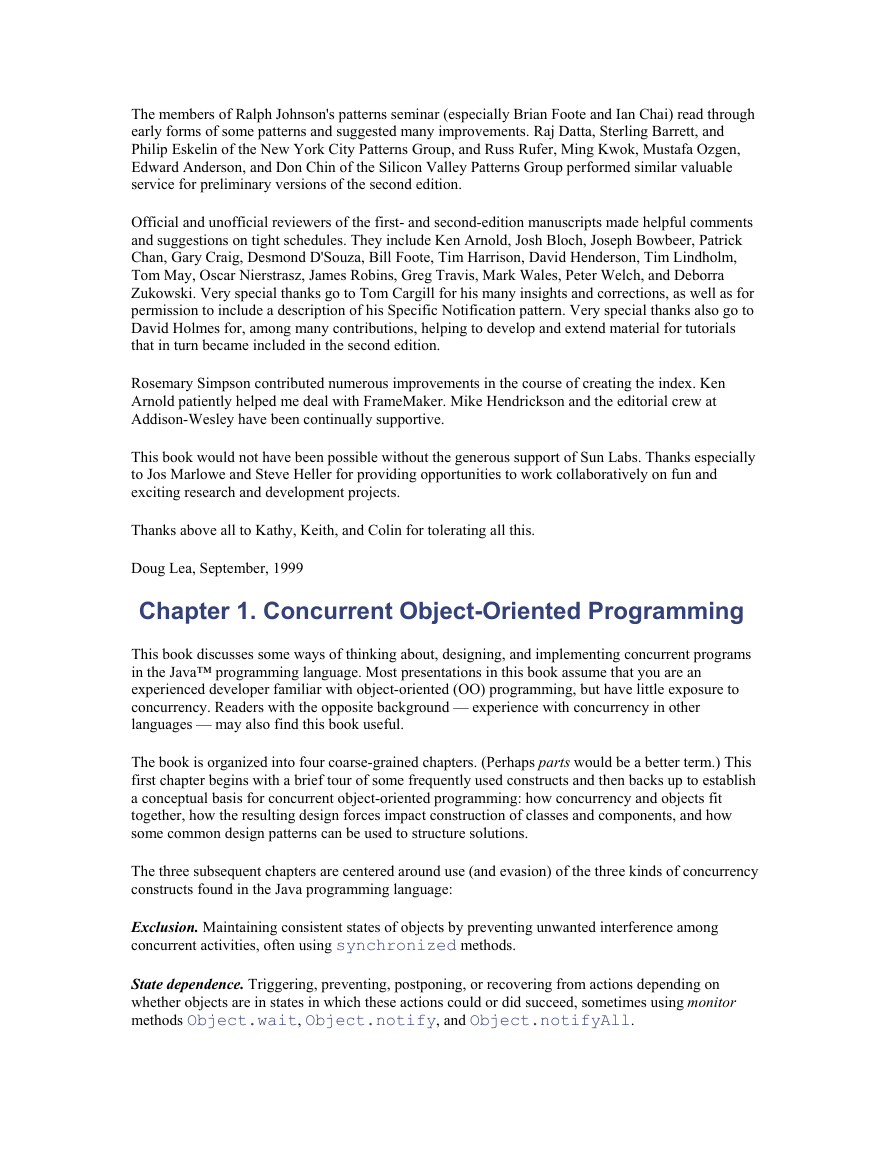
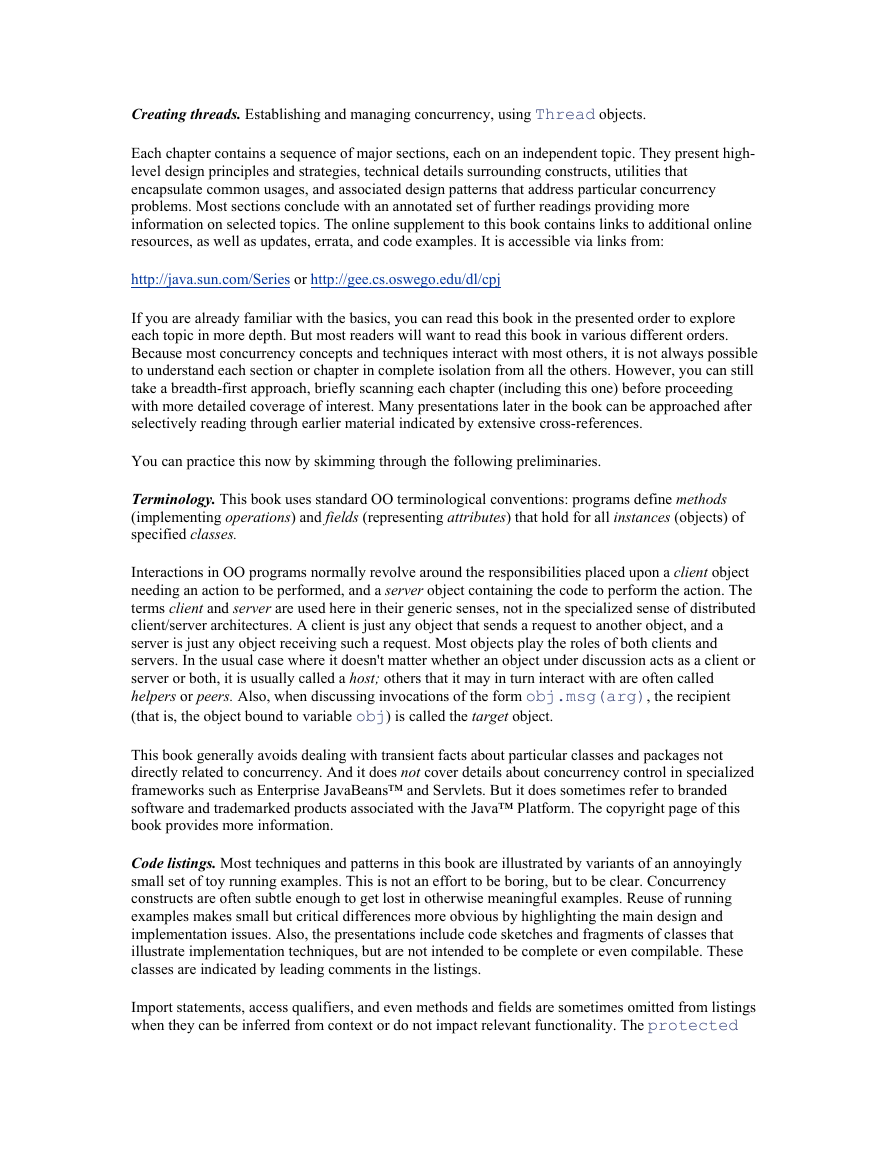
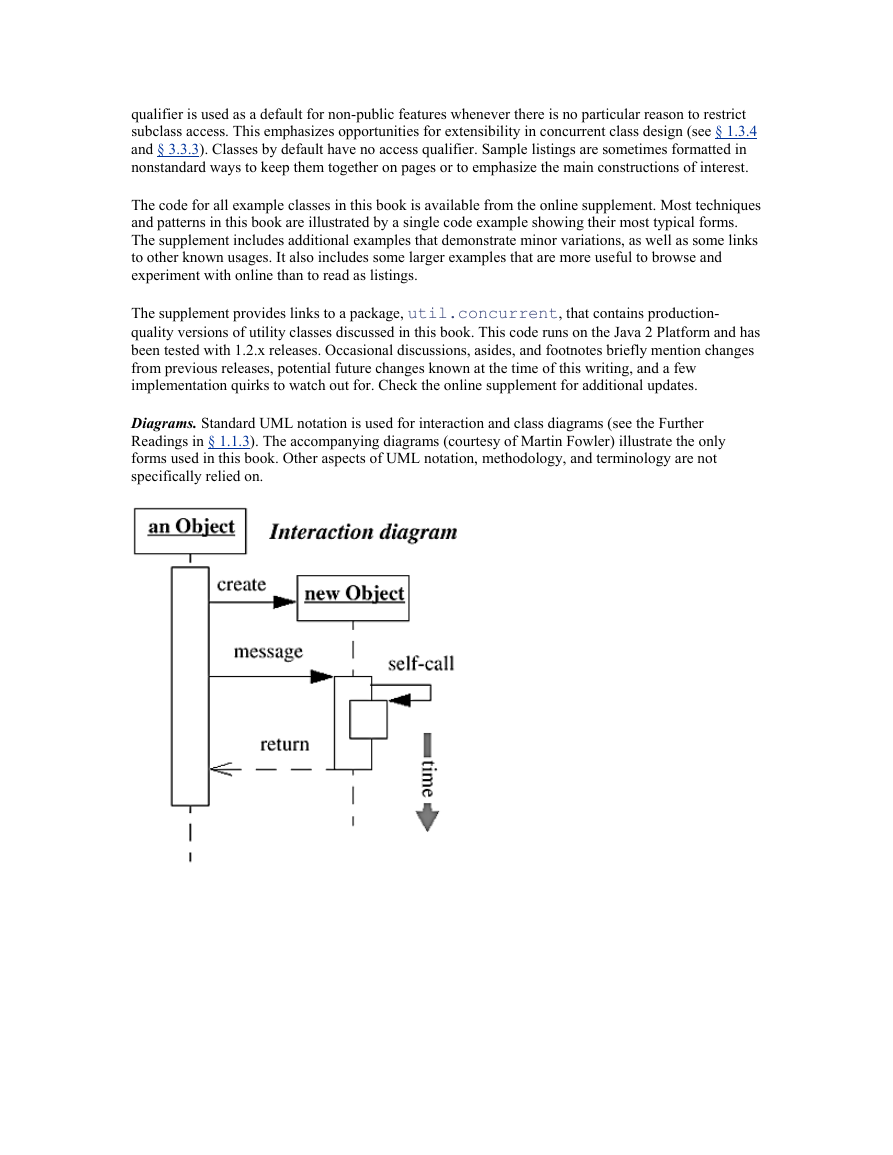
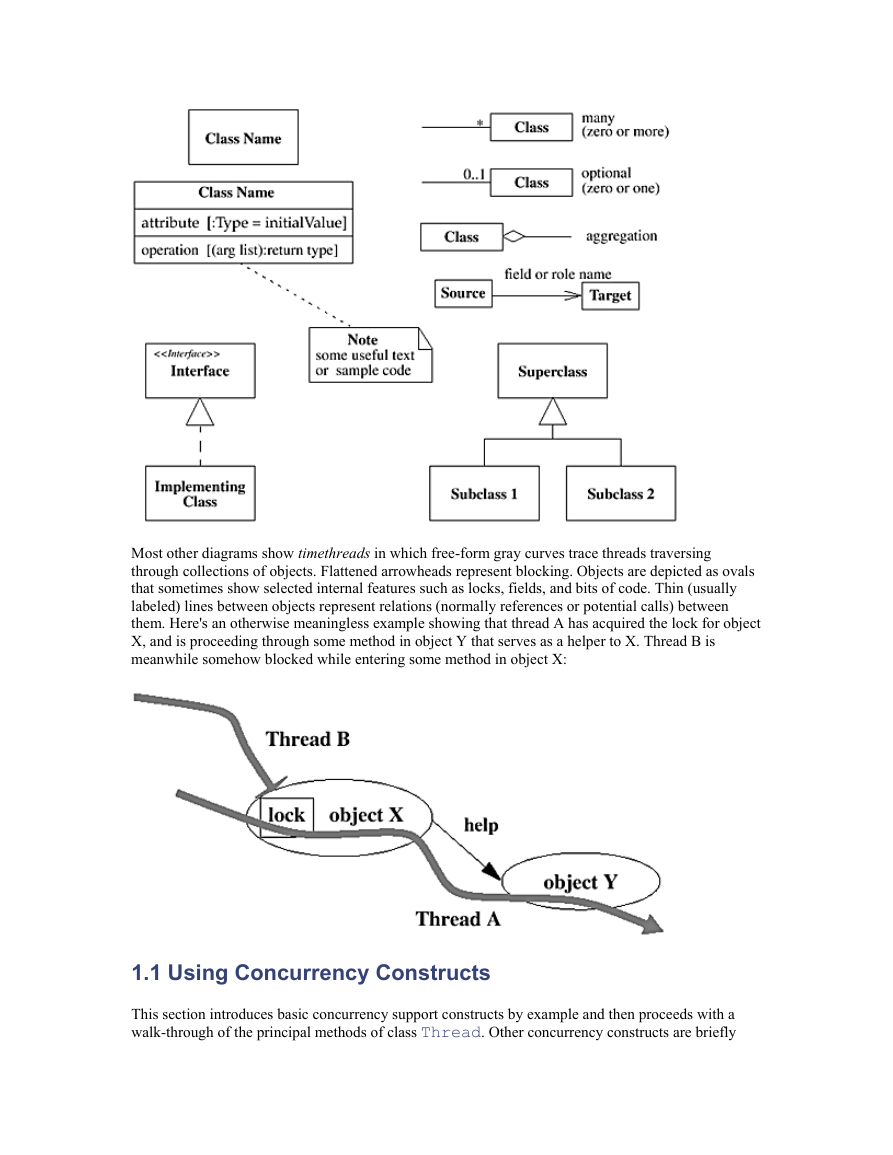
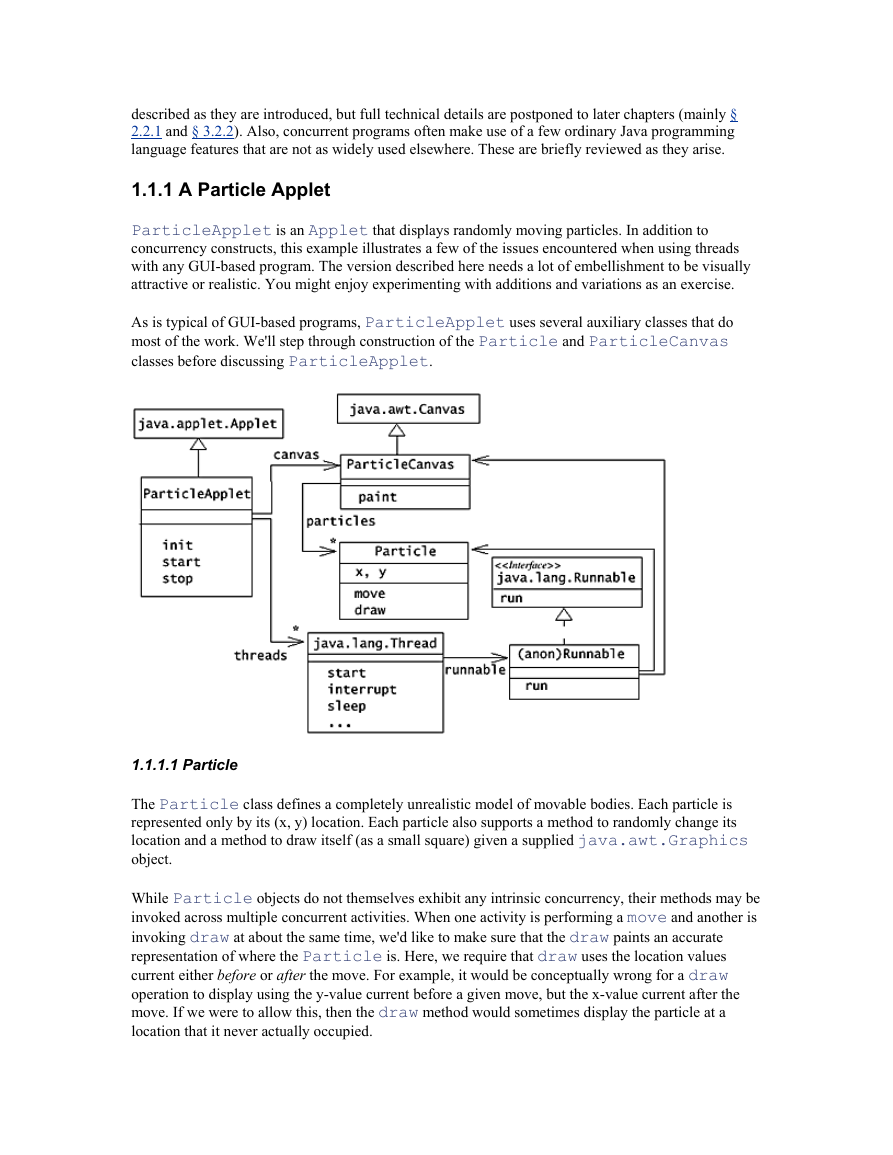








 2023年江西萍乡中考道德与法治真题及答案.doc
2023年江西萍乡中考道德与法治真题及答案.doc 2012年重庆南川中考生物真题及答案.doc
2012年重庆南川中考生物真题及答案.doc 2013年江西师范大学地理学综合及文艺理论基础考研真题.doc
2013年江西师范大学地理学综合及文艺理论基础考研真题.doc 2020年四川甘孜小升初语文真题及答案I卷.doc
2020年四川甘孜小升初语文真题及答案I卷.doc 2020年注册岩土工程师专业基础考试真题及答案.doc
2020年注册岩土工程师专业基础考试真题及答案.doc 2023-2024学年福建省厦门市九年级上学期数学月考试题及答案.doc
2023-2024学年福建省厦门市九年级上学期数学月考试题及答案.doc 2021-2022学年辽宁省沈阳市大东区九年级上学期语文期末试题及答案.doc
2021-2022学年辽宁省沈阳市大东区九年级上学期语文期末试题及答案.doc 2022-2023学年北京东城区初三第一学期物理期末试卷及答案.doc
2022-2023学年北京东城区初三第一学期物理期末试卷及答案.doc 2018上半年江西教师资格初中地理学科知识与教学能力真题及答案.doc
2018上半年江西教师资格初中地理学科知识与教学能力真题及答案.doc 2012年河北国家公务员申论考试真题及答案-省级.doc
2012年河北国家公务员申论考试真题及答案-省级.doc 2020-2021学年江苏省扬州市江都区邵樊片九年级上学期数学第一次质量检测试题及答案.doc
2020-2021学年江苏省扬州市江都区邵樊片九年级上学期数学第一次质量检测试题及答案.doc 2022下半年黑龙江教师资格证中学综合素质真题及答案.doc
2022下半年黑龙江教师资格证中学综合素质真题及答案.doc